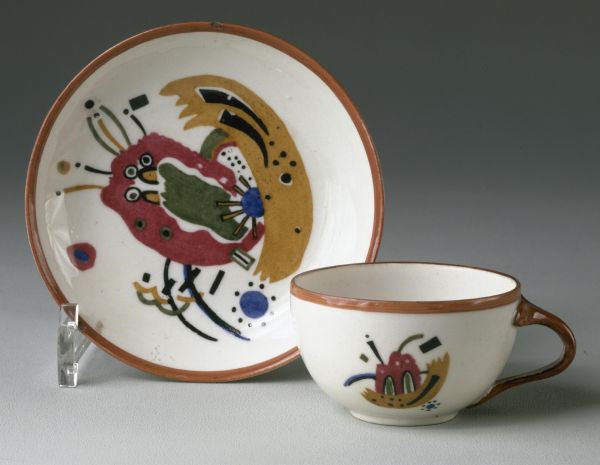|
|
Cup and Saucer with Abstract Compositions. 1920s

Kandinsky Vasili,
Overglaze paintwork on porcelain
Чашка: В.— 5,0; Дм.— 7,9; блюдце: Дм.— 13,3
State Russian Museum
Пост.: время и источник поступления не установлен
Annotation
In December 1921, not long before he left Russia, in Berlin, Kandinsky created several designs for the State (Imperial until 1917) Porcelain Factory in Petrograd. The novelty of nonobjective decor quickly attracted the attention of porcelain enterprises. In the first post-revolutionary years, many of them were searching for decor that resonated with the radical changes in the life of the country. The teacup belonging to the Russian Museum was painted at the Dmitrov (Gardner until 1917) Factory. Kandinsky was a designer who designed right up the smallest details, and expressively correlated his drawings to the hemispherical shapes of the objects; the red-orange rims along the edge of the vessels restrain the beautiful flying objects.
Author's Biography
Kandinsky Vasili
Kandinsky, Wassily (Vasily Vasilyevich)
1866, Moscow - 1944, Neuillysur-Seine (France)
Painter, graphic artist, book illustrator, writer on painting and poetry. Studied law and political economy at the Moscow University (1885-93). Studied art at Anton Aube's private studio (1896-97) and the Akademie Franz von Stuck in Munich (1900). One of the founders of the Phalanx group (1901), organised the Neue Kimst-lervereinigung in Munich (1909). Contributed to the exhibitions of the Jack of Diamonds (1910, 1912), Der blaue Reiter (1911-12) and Galerie Der Strum (1913). Worked for Department of An, People's Commissariat of Education (1918), headed the Museum of Painterly Culture in Moscow (1919-20). Emigrated to Germany (1921) and France (1933).

